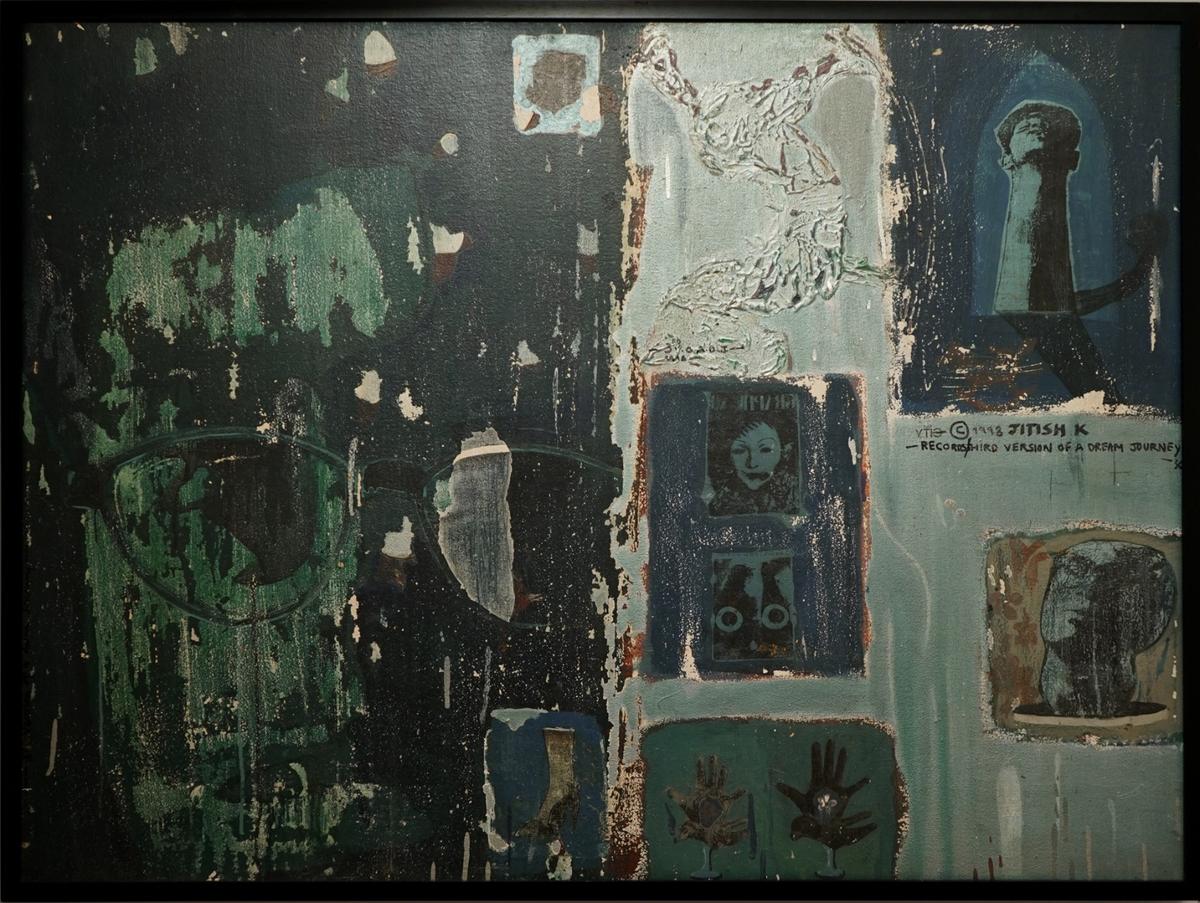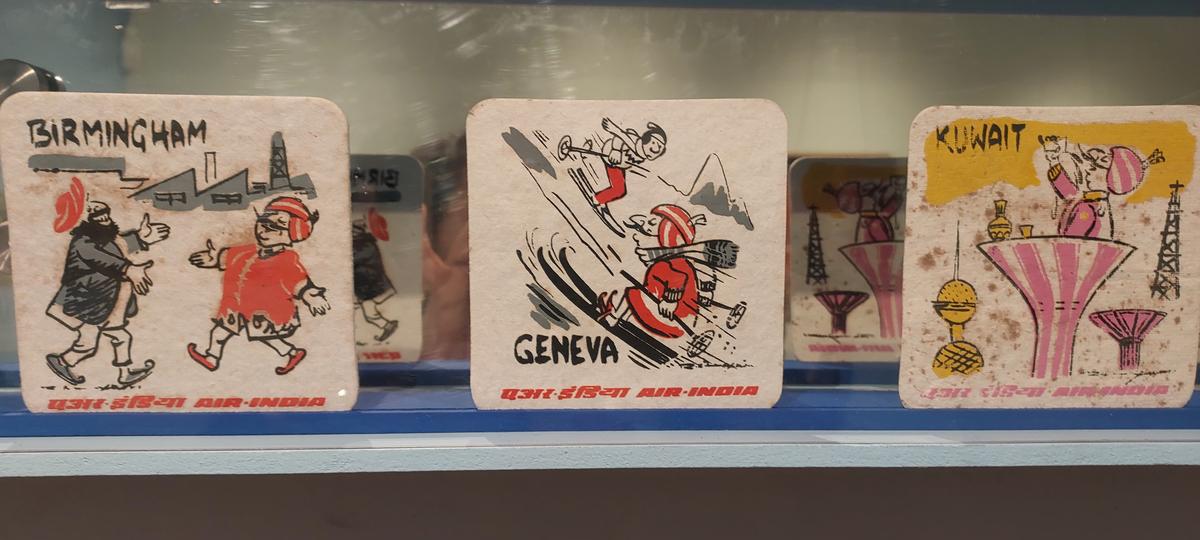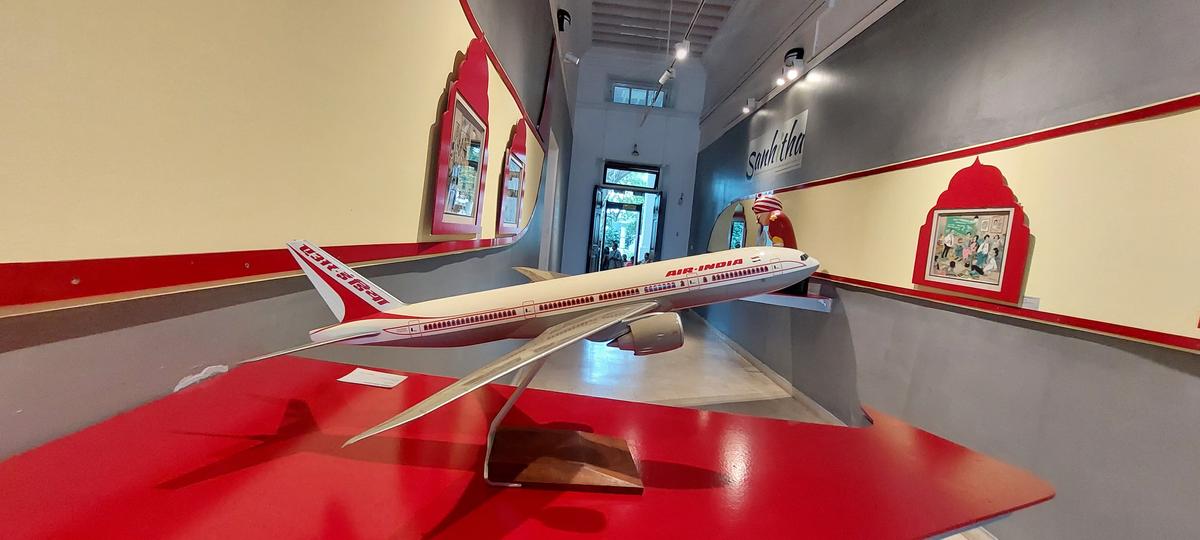Once upon a time, there was a maharajah who flew around on his private jet, sharing glimpses of India with people all over the world. And whenever he returned to his country, he would come laden with tales of the many wonders he had seen during his travels.
The Maharajah (for that was his name and title) has long been the mascot for Air India, the country’s national carrier; though, over the years, his role has been diminished and he is rarely seen in public. For those who remember his glory days, or wish to relive the nobility of a bygone era, the National Gallery of Modern Art in Bengaluru (NGMA-B) is displaying art from the Air India Collection.
Titled Sanhita : A New Beginning for the Air India Collection, the exhibition showcases works of art that Air India collected over the years. The public rarely gets a chance to view these pieces, which were housed in the Air India offices in Mumbai. They were recently transferred to the NGMA and are on display for the first time in Bengaluru.
According to Darshan Kumar YU, deputy curator at NGMA-B, Sanhita is an exceptional offering as it showcases important artworks, particularly from the Progressive Art Group (these were Indian artists who broke away from traditional art forms and established modern Indian styles), and offers insight into the culture and heritage of the times.
Start of a repertoire
Air India started collecting works of art and cultural assets in the early ‘60s — a time when modern Indian art needed the patronage, says Darshan, who not only curated the show but also conceptualised its design and display.
Art works on display at Sanhita: A new beginning for the Air India Collection at NGMA-B.
| Photo Credit:
Special Arrangement
The idea of creating such a collection began when artist B Prabha walked into the Air India office in Mumbai, following her graduation from the Sir JJ School of Art in the 1950s, to sell her artwork. Six of Prabha’s paintings were purchased for “a sum of 87 rupees and 8 annas each” and were later displayed at the Air India Booking Office in London, garnering a lot of attention.
This prompted the start of a project to not only showcase Indian culture, but also give fillip to the airline’s reputation and came to be known as the Maharaja Collection. “These works of art would be displayed at official airline launches and other prestigious events where bhoota kunita and other cultural performances from different States would also be presented,” says Darshan.
The collection built up over the years, and in some instances, a barter system was chalked out where artists would give the airline artworks in lieu of airfare. When artist Jitish Kallat had a show in London and the gallery could not afford his fare, Air India sponsored his travel. As a token of his gratitude, he created a painting which is on display at Sanhita, adds Darshan.

Jitish Kallat’s Untitled piece at NGMA
| Photo Credit:
Special Arrangement
The untitled piece of acrylic on canvas, was executed in 1998, and reflects Jitish’s attention to detail, colour and texture, in his quest to capture contemporary life.
Over time, the Air India Art Collection amassed over 10,000 pieces of art and artefacts that comprised paintings, sculptures, prints, photographs and more, besides rare books and clocks, costumes and jewellery. The collection of six decades is testament to both, traditional and modern Indian art history.
Change of hands
Needless to say, the transfer of this collection from Air India’s treasure troves to NGMA’s archives was a time-consuming process taking the the better part of five years, and was completed late last year.
Darshan says, “The Air India building in Mumbai housed a huge collection built over a period of time with works from so many artists; there were many formalities that had to be taken care of, especially in terms of documentation, before they were moved to NGMA Delhi.“

The Maharaja statuette
| Photo Credit:
Ruth Dhanaraj
Sanhita comprises as many as 180 works by iconic Indian artists such as MF Husain, KH Ara, FN Souza, B Vital, Kanchan Chandra, Arpana Caur, Pillo Puchkanwala and Achuthan Kudallur, alongside sculptures by Janaki Ram, Bhadri Narayan and S Nandagopal, among others.
A statement by NGMA-B reads, “The transfer of Air India’s collection to NGMA symbolises the enduring connection between Indian art and institutional treasures, ensuring that the legacy of Air India’s art collection remains a vital part of our artistic heritage. This collaboration has been instrumental in preserving and promoting India’s cultural history.”
Royal welcome
A passageway in deep red and cream welcomes visitors to Sanhita — starting with a mirror ensconced in a jharokha frame reminiscent of the airline’s windows. Illustrations by celebrated cartoonist Mario Miranda line the corridor throwing humorous light on the workings of the industry.
“The purpose of placing a mirror there was to look inwards and associate yourself with the journey of Air India. Not only is it about the art, but also the airline as a cultural asset. At its peak, Air India was a luxurious airline with journals and magazines of its own, crafting souvenirs to hand out to privileged passengers and of course, the use of the Maharaja as their ambassador,” says Darshan.
A statuette of the Maharaja welcomes visitors, while brightly-coloured illustrations and souvenirs draw in visitors who may not be art lovers in the classical sense. Posters, postcards and other memorabilia depicting the Maharaja, as a debonair ambassador of all things Indian and his experiences in far off lands, make the showcase imminently relatable, especially a set of coasters designed by cartoonist RK Lakshman in his trademark style.

The Maharaja illustrations and souvenirs for NGMA-B’s Air India collection.
| Photo Credit:
Ruth Dhanaraj
A hand fan with a map of India cobbled together with different tourist attractions, and pages from the Maharaja’s Book of Fairy Tales lining a wall, beckons visitors to participate in this immersive exhibition. Pages of an early inflight magazine, blown up and displayed on the wall, shed light on India’s culture and heritage. “These small-format stories make the show interesting and inclusive for visitors of all ages,” says Darshan.
“Besides, there is a clever play of words in The Book of Air, which offer a metaphorical understanding of Air India,” he adds, indicating the sepia-tinted pages which show the Maharajah at the salon in “Hair-India” or in a rickshaw as “Fresh-Air-India” or his head as a hot air balloon in “Lighter-than-Air-India”.
According to Darshan, it was not thoughtfulness or gimmickry alone that prompted Air India to bring out souvenirs and miniatures or postcards celebrating “100 Years of Bombay” or a particular wildlife species. “They were keen on crafting items that were engaging and utilitarian as well. In an age where our entire lives revolve around our phones and laptops, the charm of those days remain unmatched.”

The Maharaja illustrations and souvenirs for NGMA-B’s Air India collection.
| Photo Credit:
Ruth Dhanaraj
Wonder walk
While the entire collection includes rare works, a must-see is a piece by Spanish surrealist Salvador Dali. “The artist was commissioned by the airline to create a souvenir and he crafted an unusual ashtray. From one side it resembles a swan, but when viewed from another angle, one can see two swans and an elephant. If turned upside down, a swan and two elephant heads are visible,” says Darshan.
As many as 600 editions of this piece crafted out of glazed bisque porcelain in two iterations — a blue or green serpent forming the rim of the ashtray. For his efforts, Dali requested a baby elephant as payment and the ashtray is part of an immersive and interactive display at Sanhita. “It is interesting to see a proficient and internationally known artist in contrast with India’s art scene at the time. It also captivates viewers’ interest on how versatile artists can be.” he says.

The Dali ashtray
| Photo Credit:
Special Arrangement
Among the other works, look out for art by husband-wife duo B Vital and B Prabha, Pilloo Pochkhanawala, tantric artist GR Santosh, a set of small format works by VS Gaitonde, an eight work cluster by Badri Narayan, and a huge canvas from MF Husain’s Horses series.
“Anjolie Ela Menon’s window works are also on display. Painted on windows, they have a 3D feel and have been beautifully incorporated into the space. With NGMA-B being a 100-year old building, her art offers a different connect,” he says.
With over 180 works on display to marvel at, plan to spend the better of your day soaking in the spirit of these masters. It is a chance that may not come by in a while.
Sanhita: A New Beginning for the Air India Collection will be on display at NGMA Bengaluru till August 31, 2025, with the possibility of an extension. Call 08022342338 for details.
www.thehindu.com (Article Sourced Website)
#Air #India #Art #Collection #NGMA #Bengaluru #carries #whiff #nostalgia
